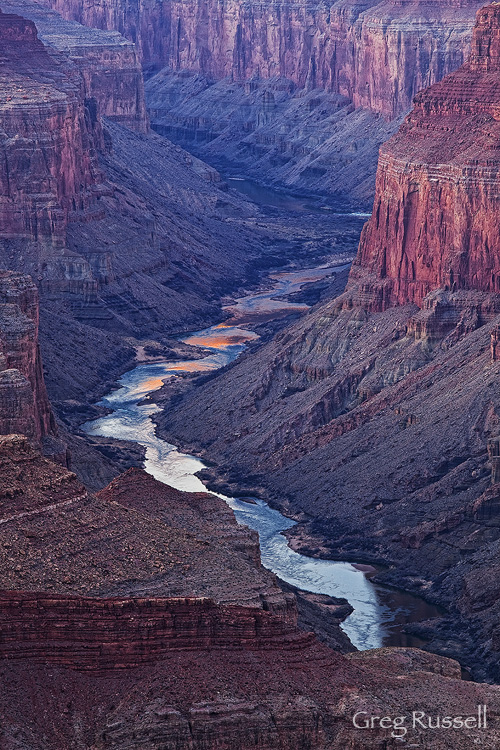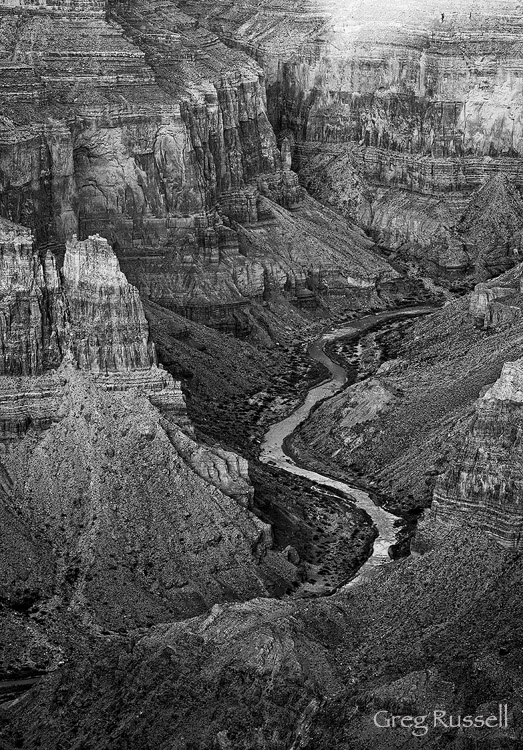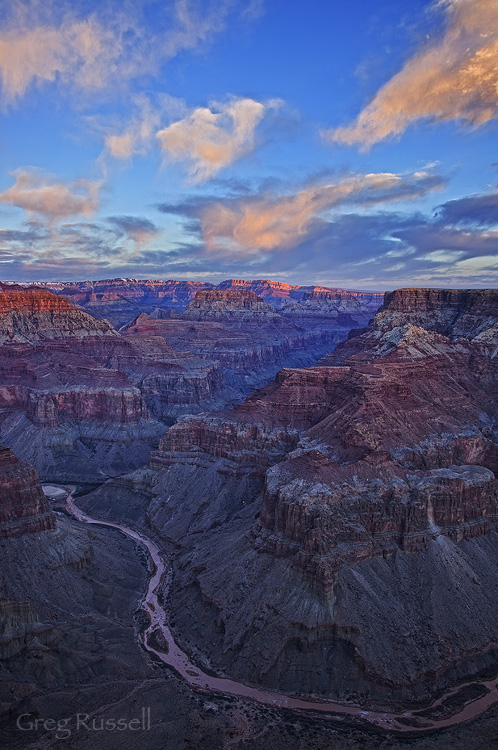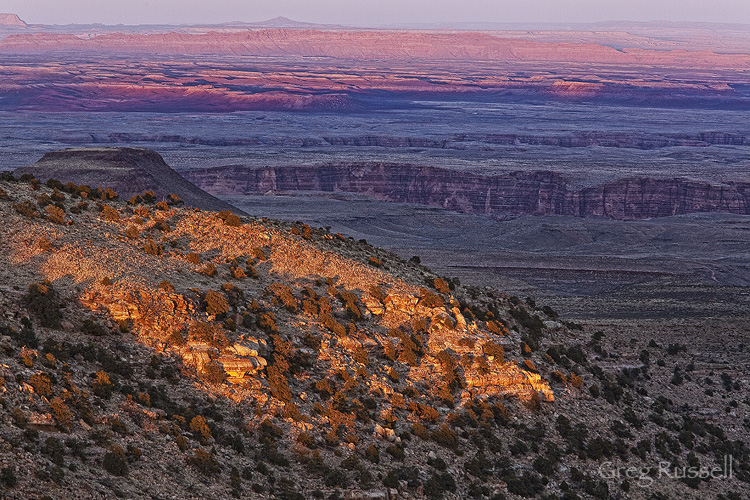For February at 6500′, it’s a warm day–about 40 degrees–and the sun makes it feel even warmer as we hike across the windswept grassland plateau. Snow still blankets the north-facing slopes, but the rest of the ground is free of snow, soft, and slightly muddy in places.
Everywhere, almost literally, signs of elk abound; I have never seen so many turds and tracks in one place. This small plateau must be great winter ground for them. I haven’t seen (or felt) any invasive Drooping Brome (Cheat Grass) in my socks all day, only native Bouteloua (Grama Grass). Here on the Colorado Plateau, where some areas have been grazed extensively, that must be one sign of a healthy ecosystem.
Through the Grama we hike, our heavy packs weighing us down more and more, until–finally–the east rim of the Grand Canyon reveals itself to us.
Last weekend, Jackson Frishman invited me to join him on a trip to visit the confluence of the Colorado and Little Colorado Rivers. Jackson’s proposal was ambitious: nearly 40 miles of hiking in 2.5 days, with no water along the route (we had to carry our own water cache). He introduced it to me as a hare-brained plan, and honestly that’s all he needed to say to get me on board.
Jackson told me he wanted to visit the confluence because the Grand Canyon Escalade–a proposed tourism development on the western edge of the Navajo Nation, which overlooks the confluence. If the project passes, it would include a tram from the rim down to the Little Colorado River (read more about Escalade here, here, and here). For me, it was a good time to familiarize myself with this area, learn a little more about the proposal, as well as to visit the Grand Canyon again; I began my backpacking life there, and the Grand Canyon evokes many special memories for me.
On Friday night, we discussed the final plans over beers and enchiladas, and it was clear that the stress of planning the trip had turned into excitement for what lied ahead. We started out on Saturday morning; our packs were weighed down with a couple of extra gallons of water for the return hike. We dropped the water underneath a couple of stiff piñon boughs to keep it from freezing, as well as to keep it away from the ravens which were surely watching us. As we got closer to the park service boundary with the Navajo Nation, we found an old hogan, with a missing west wall; the doorway of a Navajo hogan faces east to receive the morning sun and it’s good blessings, and when someone dies in a hogan they are carried out through a hole that has been knocked in the west wall, then the home is abandoned.
After several more miles, we crested a hill and scared a large herd of maybe 200 elk out of a drainage. They must have known about a water source that we didn’t. We watched the elk until they disappeared into the horizon and would see them several times over the next couple of days. The final push to the east rim was tortuous; buttes on the north side of the Colorado River were visible, but they never seemed to get any closer. However, finally, after what felt like hours we arrived at Cape Solitude.
Solitude indeed. We had not seen any other human footprints all day, and aside from a windbreak built from rocks, our campsite showed no sign of other humans at all. In the second-most-visited national park, solitude can be tough to come by. It’s a special feeling to have a piece of the Grand Canyon all to yourself.
We woke up to a windy but beautiful sunrise the next morning and hiked back to our water cache (thankfully untouched) from the day before. After rehydrating, I was happy to hike to our second night’s camp, closer to our trailhead, but with another private view of the canyon’s rim. Horned larks flitting through the sagebrush and elk were our only company. The next morning Jackson and I returned to our cars, shared a couple of cold beers, and parted ways.
We hiked through the Grama–through a healthy ecosystem–to a part of the Grand Canyon only a few people get to see. Elk tracks went right up to the rim. I wonder if they admire the view from time to time? In my twentieth year of visiting the Grand Canyon, I still stand in awe of the vast landscape, and can’t help but wonder if some of that awe would be diminished if I could take a tram all the way to the bottom, or if–consequently–the elk tracks didn’t go all the way to the rim.
P.S. You can also read Jackson’s post and see his image of Cape Solitude at his blog here. His blog is always worth a visit, with fantastic writing and wonderful imagery.





Well photographed and well written, Greg! With any luck, I’ll have some of my stuff up soon. It’s wonderfully ironic that one of my favorites of your work from the trip is that last shot, looking away from the Grand Canyon. Certain people like to say it’s become virtually impossible to make an original image in Grand Canyon National Park, but that’s one I’ve never seen before. As we were discussing on the trail, you don’t really know a place until you’ve experienced some of its less glamorous sides, and I definitely feel like our three-day march through the grama gave me a new feel for the place.
I guess that was Challenge Greg.
I like your pictures and your Story
Fantastic images and post, as well as some insightful thoughts. The proposed development isn’t a bad idea – it’s a terrible one. I read about it not long ago and was horrified. I realize the Natives there live in poverty but there has got to be a better resolution than this hare-brained idea. Thank you for providing a thoughtful discussion on this, Greg.
Wonderful images (and what surely must have been a wonderful trip), Greg! I visited the east rim (not as remotely as you have–yet) for the first time last year, and was immediately smitten. The Little Colorado Gorge and the confluence, even glimpsed from a distance, are just breathtaking. I had not heard of this proposed development, and I dearly hope the idea is abandoned.
Greg, love the Grama contruct!
I have yet to visit the Grand Canyon and you’ve inspired me, for sure. The first image in this post is my favorite and an absolute stunner.
Well done — thanks for the story.
All beautiful images but the real joy is knowing you can still find new routes to trek, new views to photograph and do so almost alone. Just a trekking companion and the wilderness with you. I won’t be taking the tram.
Isn’t it ironic that the natives may permanently alter, certainly not improve, their long-time home? On reading your beautiful reportage in both words and images, a sadness and feeling of great loss come over me. It is truly a dark day when those who once tried so hard to educate “Whites” how to care for the land, turn to selling what is sacred. I hope something changes their plans.
Thanks everyone for your comments, and for your thoughts on the proposed resort development; I figured I’d be preaching to the choir in that regard.
I put it in the blog post itself, but make sure to check out Jackson’s blog post on the subject here. He gives a little more attention to the development than I do, and I feel he has a very balanced perspective on it. Some pretty wonderful images to boot!
I suppose that being somewhat curmudgeonly at an advancing age I should hesitate to oppose something I have only a cursory knowledge of, but I am generally opposed to resorts in national parks and all wild places. I appreciate that some people require accommodation for visiting these places, but even just a tram to the bottom seems a sacrilege. I will read a bit more using the links from Jackson’s post.
This seems a fine adventure the two of you undertook. Beautiful country and your images do them strong justice Greg. I would love such a trip but I am not sure I would manage well. But you words surely shared quite a bit.
As to David’s point about the irony…it appears pretty much the new American creed among all populations to forgo preservation and much thought of the future (political protestations notwithstanding) for the temporary gains of modern development. Surely people need to eat and be housed but sometimes I think the price we pay is not very well thought out.
I discovered your site searching pictures to compare with a video I’m editing. When I read of this insane project about a tram at Cape Solitude I immediately posted a message on the link you gave. Free enterprise has its limits. We’ve seen the result of the insane Glen Canyon dam and its consequences on the whole canyon, Skywalk another stupidity by insane people just greedy for money is a scandal in itself. But here we’re facing a disrespect of the beliefs of a whole Nation whose President do not; I’m French and come every year or so at GCN to hike and visit friends at GCFI of which I’m a member. I’ve been 3 times to the confluence once on a raft trip and twice hiking the Tanner and Beamer trails and it’s always full of emotion that I look at this incredible sight from the river. I just cant imagine coming on my raft trip schedules in 2017 and find a crowd there and why not soft drinks and burgers sellers! I have decided to post a paper on my blogs and mention this sacrilege on the video I’ll upload on Vimeo in a few days. If you wish to access the video send me an email. Claude from PARIS-France
Claude, thank you so much for your comment. I’d very much like to visit the confluence at river level and see it that way as well. Maybe later on this year.
I agree that this is a sacrilege to not only the Navajo and Hopi people, but also the rivers (Colorado & Little Colorado) themselves. I hope this project is stopped, although it looks more and more like it may happen.
You might enjoy this article by Kevin Fedarko, a former GC river guide:
http://www.nytimes.com/2014/08/10/opinion/sunday/two-development-projects-threaten-the-grand-canyon.html?_r=0
I’d love to be able to access the video, and will send you an email. You can also post the link here, if you so choose.
Cheers,
Greg Russell
Hi Greg,
We are thinking of doing this Cape Solitude hike in October. How long did the 15 miles take you? Was it easy to navigate? Did you stop at Comanche Point along the route?
And lastly, I think it might be breeding season for elk then. Are they always there and do you think it might be dangerous passing by them as I’ve heard they gather at the Comanche Point peninsula which we were hoping to stop at? Thanks Ross
I realize not all Navajos support this project, but it is a shame that some Native Americans would whore their sacred lands out in the same ways the white man has done. The white way may be popular, but that does not make it the right way. And this is coming from a white man himself. Aldo Leopold once made a comment somewhere along the lines of how we abuse land when we treat it as a commodity, whereas we would do well to live in harmony with it as part of the community. Before the white man came, the Native Americans knew this and lived by it. Let us hope that the Navajo Nation has not been so corrupted by the white man’s ways that it betrays the very principles it has lived by for centuries.